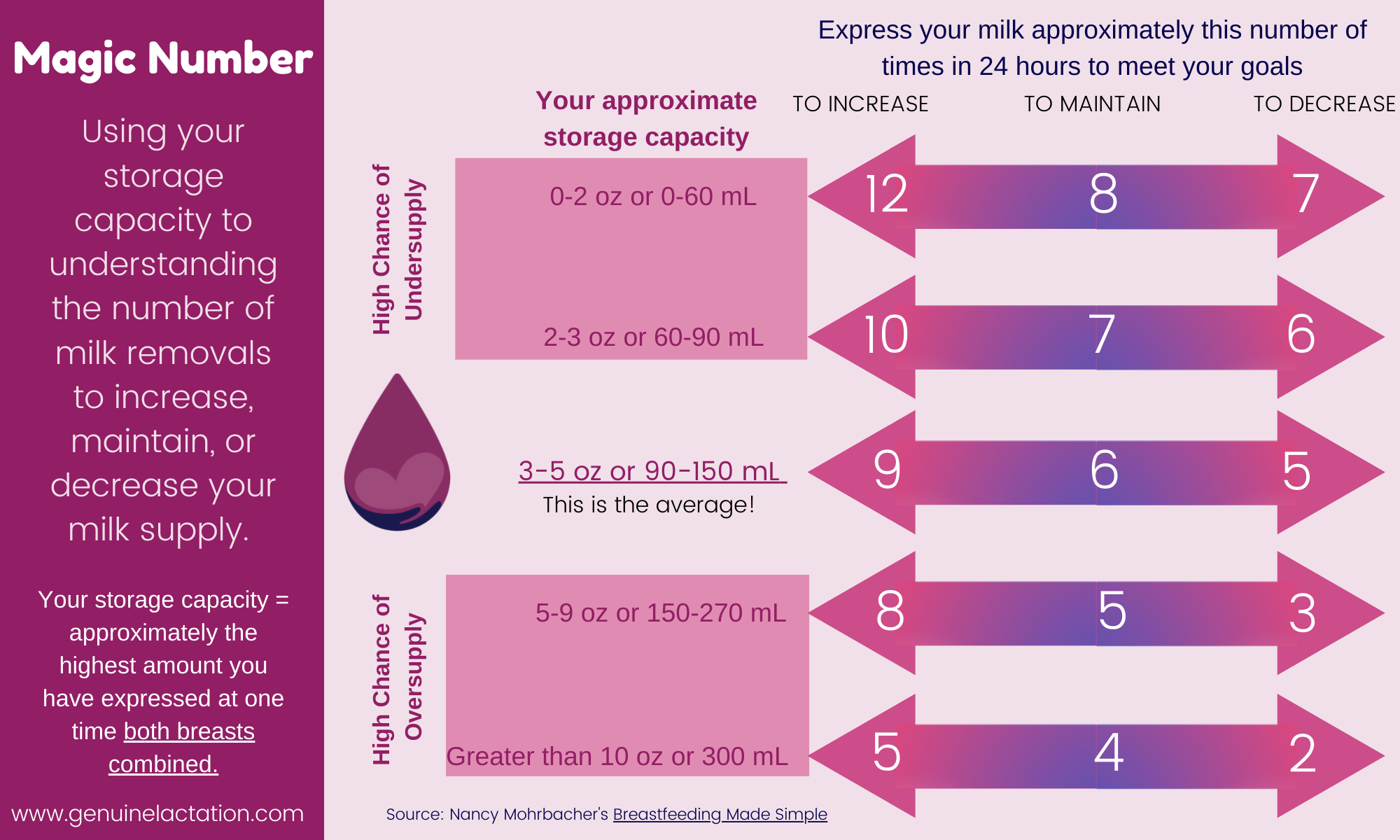How Many Times Do I need to Nurse or Pump?
There is a really popular graphic that floats around on social media to explain the idea of the “Magic Number.” This seems on it’s surface to link the idea of “storage capacity” or the maximum amount of milk your breasts can hold with the number of times you must remove your milk each day to meet your goals. It’s a fairly simple concept, and it makes sense to parents. We need to take a look at the idea and understand it’s limitations in order to make sure this idea supports your breastfeeding goals.
This concept comes from Nancy Mohrbacher and was a way to conceptualize for breastfeeding parents who had to be separated from their babies how many times they would need to pump to maintain their milk supply. The idea is that if you remove your milk by nursing or pumping a certain number of times in 24 hours it influences whether your supply increases, decreases or stays relatively stable. For working parents this was an issue where for many months they would be able to pump 2 or 3 times and nurse 5-6 times when home with their baby maintaining their supply, but once their baby slowed nursing in the evenings and overnight they experienced a supply drop because the number of milk removals had dropped below their magic number, and the normal infant behavior of increasing daytime nursing was not happening due to the separation.
This idea has gained popularity as the number of parents exclusively pumping has grown with increased access to breast pumps. Let’s face it, no matter how strong the motivation to pump, or how committed the pumping parent is, pumping is not fun. Pumping is hard work, and the idea that you can maintain your milk output with fewer pump sessions is a welcome idea. Pumping parents are often trying to pump at work while juggling their job, or pumping at home while juggling children. Many will latch on to this idea to help themselves be more confident in dropping a pump session, and while the idea will work out for many parents, it may have disastrous effects on long term milk production for others.
So lets look at the times that this idea isn’t quite applicable so that you can make the choices about your milk production that are right for you.
1.) You are less than 12 weeks postpartum.
I know this is an incredibly difficult period of time, and is extremely demanding on your time and energy. Milk may be very abundant during this time, as your milk supply is still getting a boost from hormonally driven production. Dropping pumps now before your milk supply is well established and more controlled by stimulation and milk removal (referred to as the 12 week regulation) can reduce your long term milk production capabilities by signaling to your body you do not need that full supply. Even if you have an oversupply, this is not a great way to regulate your milk production. If you are struggling with an oversupply reach out for a consultation and we will talk about ways to reduce supply without harming long term milk production.
2.) If you have low supply.
Take this idea and file it away under don’t even waste the energy trying to remember it. The only part that applies to you is that if you are not producing a full milk supply you need to pump at least 8 times per 24 hours to stimulate your milk production. Aside from that you need help from a lactation consultant to help find the cause of your low supply, and properly address it. You can’t pump your way out of a thyroid problem or hormonal issue, no matter how much you want it to work. This concept has led to distress and unsustainable pumping plans when parents think this will be the answer to their breastfeeding struggles, and it’s not being used as part of a comprehensive plan for addressing low milk supply.
I know that pumping whether occasional, at work, or exclusively pumping is hard work. If you need help making your pumping plan work to meet your goals schedule a consultation today and we will come up with a plan tailored to your needs. You don’t have to do this alone, and you don’t have to risk your milk supply on bad advice from even the most well intentioned sources.
View Related Articles…

